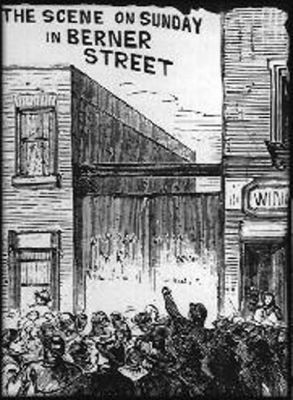According to the Times, Eagle described the gates as being "about 9ft 2in wide"
This report from the Daily News describes the club and yard;
"At the entrance to the court are a pair of large wooden gates, in one of which is a small wicket for use when the gates are closed. At the hour when the murderer accomplished his purpose these gates were open; indeed, according to the testimony of those living near, the entrance to the court is seldom closed. For a distance of 18 or 20 feet from the street there is a dead wall on each side of the court, the effect of which is to enshroud the intervening space in absolute darkness after sunset. Further back some light is thrown into the court from the windows of a workmen's club, which occupies the whole length of the court on the right, and from a number of cottages, occupied mainly by tailors and cigarette makers, on the left. At the time when the murder was committed, however, the lights in all of the dwelling-houses in question had been extinguished, whilst each illumination as came from the club, being from the upper storey, would fall on the cottages opposite, and would only serve to intensify the gloom of the rest of the court. From the position in which the body was found, it is believed that the moment the murderer had got his victim in the dark shadow near the entrance to the court he threw her to the ground, and with one gash severed her throat from ear to ear."
This report from the Daily News describes the club and yard;
"At the entrance to the court are a pair of large wooden gates, in one of which is a small wicket for use when the gates are closed. At the hour when the murderer accomplished his purpose these gates were open; indeed, according to the testimony of those living near, the entrance to the court is seldom closed. For a distance of 18 or 20 feet from the street there is a dead wall on each side of the court, the effect of which is to enshroud the intervening space in absolute darkness after sunset. Further back some light is thrown into the court from the windows of a workmen's club, which occupies the whole length of the court on the right, and from a number of cottages, occupied mainly by tailors and cigarette makers, on the left. At the time when the murder was committed, however, the lights in all of the dwelling-houses in question had been extinguished, whilst each illumination as came from the club, being from the upper storey, would fall on the cottages opposite, and would only serve to intensify the gloom of the rest of the court. From the position in which the body was found, it is believed that the moment the murderer had got his victim in the dark shadow near the entrance to the court he threw her to the ground, and with one gash severed her throat from ear to ear."



Comment